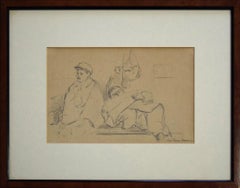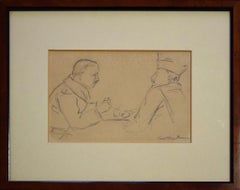Paul-Franz Namur Art
1877-1958
Paul-Franz Namur was born in 1877 in Valenciennes, France. Namur was a French painter, drawer and illustrator who realized portraits and landscapes. He studied at the Academy of Fine Arts in Valenciennes, then in Paris at the Académie Julian. He was oriented at the same time towards the portrait, the landscapes and the allegories.
to
2
2
2
Overall Height
to
Overall Width
to
2
2
2
1
1
1
1
2
2
2
6,886
3,210
2,514
1,217
2
Artist: Paul-Franz Namur
Man With Beret And Lying Man - 1940s - Paul-Franz Namur - Drawing - Modern
By Paul-Franz Namur
Located in Roma, IT
Man With Beret And Lying Man is an original artwork realized by Paul-Franz Namur in the first half of the XX century. Pencil on paper.
Hand-signed in pencil by the artist on the low...
Category
1940s Modern Paul-Franz Namur Art
Materials
Pencil
Two Men Around a Table - 1940s - Paul-Franz Namur - Drawing - Modern
By Paul-Franz Namur
Located in Roma, IT
Two Men Around a Table is an original artwork realized by Paul-Franz Namur in the 1940s. Pencil on paper.
Hand-signed by the artist on the lower right margin. Passepartout and wood ...
Category
1940s Modern Paul-Franz Namur Art
Materials
Pencil
Related Items
The New Haircut, 20th Century portrait of a Young Girl, drawing
Located in London, GB
Graphite on paper
Image size: 11 ¾ x 8 ½ inches (30 x 21.5 cm)
Original frame
This superbly-drawn portrait highlights the artist’s undeniable skill as a portrait artist, particularl...
Category
20th Century Modern Paul-Franz Namur Art
Materials
Graphite, Paper
"Original Joseph Stella Drawing" - 20th Century Portrait Pencil Drawing
By Joseph Stella
Located in New Orleans, LA
A pencil sketch by famed American Modernist Joseph Stella, who burst on to the American scene at the epochal Armory Show of 1913 and whose work is today in the collections of every m...
Category
Early 20th Century Modern Paul-Franz Namur Art
Materials
Graphite
Mon Colonel
By Auguste Chabaud
Located in London, GB
'Mon Colonel', pencil and crayon on paper, by noted French artist, Auguste Chabaud (circa 1914-1918). A delightfully simple drawing of a French Army colonel in profile along with clo...
Category
1910s Modern Paul-Franz Namur Art
Materials
Paper, Crayon, Pencil
The Roman Bath
Located in London, GB
'The Roman Bath', pencil on art paper (circa 1960s), School of Rome. Three broad-shouldered men make their way through the sultry corridors of the Hammam in...
Category
1960s Modern Paul-Franz Namur Art
Materials
Paper, Pencil
Boston Abstract Expressionist Hyman Bloom Original Pencil Drawing Martin Sumers
By Hyman Bloom
Located in Surfside, FL
This is a unique artwork. This is an original Hyman Bloom drawing of fellow artist and his very good friend Martin Sumers.I believe this was drawn at the “variations of a theme” at Sumers gallery in NYC. The last two photos show a poster and a card from their shows. it is not included in this listing, it is just for provenance.
Provenance: Acquired from the Sumers estate collection.
Hyman Bloom (March 29, 1913 – August 26, 2009) was a Latvian-born American painter. His work was influenced by his Jewish heritage and Eastern religions as well as by artists including Altdorfer, Grünewald, Caravaggio, Rembrandt, Blake, Bresdin, James Ensor and Chaim Soutine. He first came to prominence when his work was included in the 1942 Museum of Modern Art exhibition "Americans 1942 -- 18 Artists from 9 States". MoMA purchased 2 paintings from the exhibition and Time magazine singled him out as a "striking discovery" in their exhibition review.
His work was selected for both the 1948 and 1950 Venice Biennale exhibitions and his 1954 retrospective traveled from Boston's Institute of Contemporary Art to the Albright Gallery and the de Young Museum before closing out at The Whitney Museum of American Art in 1955. In a 1954 interview with Yale art professor Bernard Chaet, Willem de Kooning indicated that he and Jackson Pollock both considered Bloom to be “America’s first abstract expressionist”, a label that Bloom would disavow. Starting in the mid 1950s his work began to shift more towards works on paper and he exclusively focused on drawing throughout the 1960s, returning to painting in 1971. He continued both drawing and painting until his death in 2009 at the age of 9
Hyman Bloom (né Melamed) was born into an orthodox Jewish family in the tiny Jewish village of Brunavišķi in what is now Latvia, then part of the Russian Empire
At a young age Bloom planned to become a rabbi, but his family could not find a suitable teacher. In the eighth grade he received a scholarship to a program for gifted high school students at the Museum of Fine Arts. He attended the Boston High School of Commerce, which was near the museum. He also took art classes at the West End Community Center, a settlement house. The classes were taught by Harold Zimmerman, a student at the School of the Museum of Fine Arts, who also taught the young Jack Levine at another settlement house in Roxbury. When Bloom was fifteen, he and Levine began studying with a well-known Harvard art professor, Denman Ross, who rented a studio for the purpose and paid the boys a weekly stipend to enable them to continue their studies rather than take jobs to support their families.
He took Bloom and Levine on a field trip to the Museum of Modern Art in New York, where Bloom was impressed by the work of Rouault and Soutine and began experimenting with their expressive painting styles.
In the 1930s Bloom worked sporadically for the Public Works of Art Project and the Federal Art Project (WPA), He shared a studio in the South End with Levine and another artist, Betty Chase. It was during this period that he developed a lifelong interest in Eastern philosophy and music, and in Theosophy.
He first received national attention in 1942 when thirteen of his paintings were included in the Museum of Modern Art (MoMA) exhibition Americans 1942: 18 Artists from 9 States, curated by Dorothy Miller. MoMA purchased two of his paintings from that exhibition, and he was featured in Time magazine. The titles of his paintings in the exhibition reflect some of his recurring themes. Two were titled The Synagogue, another, Jew with the Torah; Bloom was actually criticized by one reviewer for including "stereotypical" Jewish images. He also had two paintings titled The Christmas Tree, and another titled The Chandelier, both subjects he returned to repeatedly. Another, Skeleton (c. 1936), was followed by a series of cadaver paintings in the forties, and The Fish (c. 1936) was one of many paintings and drawings of fish he created over the course of his career.
Bloom was associated at first with the growing Abstract Expressionist movement. Willem de Kooning and Jackson Pollock, who first saw Bloom's work at the MoMA exhibition, considered Bloom "the first Abstract Expressionist artist in America." In 1950 he was chosen, along with the likes of de Kooning, Pollock, and Arshile Gorky, to represent the United States at the Venice Biennale. That same year Elaine de Kooning wrote about Bloom in ARTnews, noting that in paintings such as The Harpies, his work approached total abstraction: "the whole impact is carried in the boiling action of the pigment". In 1951 Thomas B. Hess reproduced Bloom's Archaeological Treasure in his first book, Abstract Painting: Background and American Phase, along with works by Picasso, Pollock, and others. Both de Kooning and Hess remarked on Bloom's expressive paint handling, a key characteristic of Abstract Expressionist painting.
As abstract expressionism dominated the American art world, Bloom became disenchanted with it, calling it "emotional catharsis, with no intellectual basis." In addition, instead of moving to New York to pursue his career, he opted to stay in Boston. As a result he fell out of favor with critics and never achieved the kind of fame that Pollock and others did. He disliked self-promotion and never placed much value on critical acclaim.
Many of Bloom's paintings feature rabbis, usually holding the Torah. According to Bloom, his intentions were more artistic than religious. He began questioning his Jewish faith early in life, and painted rabbis, he claimed, because that was what he knew. Over the course of his career he produced dozens of paintings of rabbis...
Category
20th Century Modern Paul-Franz Namur Art
Materials
Paper, Pencil
French Modern Drawing by Jean Hélion - Veil Homme
By Jean Hélion
Located in Paris, IDF
Veil Homme
1947
drawing
26,9 x 21 cm
Registered on the catalogue raisonné with inventory number : N°0252 cat. B
sold without frame
about Jean Hélion (April 21, 1904 – October 27, 19...
Category
1960s Modern Paul-Franz Namur Art
Materials
Pencil, Paper
1940s Charcoal and Pencil Portrait of a Man
Located in Arp, TX
Artist Unknown
"Tie and Glasses"
c. 1940s
Charcoal and pencil on paper
13.5"x17" image 15.5"x19" paper unframed $250
Unsigned
*Listed price reflects custom framing selected by seller...
Category
1940s Modern Paul-Franz Namur Art
Materials
Paper, Charcoal, Carbon Pencil
'Young lady' on Paper by Pietro Annigoni Painter of Queen Elisabeth 1970
By Annigoni Pietro
Located in Brescia, IT
This fine and elegant woman portrait in red pastel on paper was drawn by Pietro Annigoni, an Italian artist of the 20th Century called the 'Queen's painter because he realized the Queen Elisabeth...
Category
20th Century Modern Paul-Franz Namur Art
Materials
Carbon Pencil
H 21.66 in W 15.36 in D 1.19 in
'Young lady' on Paper by Pietro Annigoni Painter of Queen Elisabeth 1970
By Annigoni Pietro
Located in Brescia, IT
This fine and elegant woman portrait in red pastel on paper was drawn by Pietro Annigoni, an Italian artist of the 20th Century called the 'Queen's pa...
Category
20th Century Modern Paul-Franz Namur Art
Materials
Carbon Pencil
H 21.66 in W 15.36 in D 1.19 in
Untitled: Seated Lady
By John LaGatta
Located in New York, NY
John LaGatta (American 1894-1977), "Untitled: Seated Lady", Signed Figurative Pencil Drawing on Paper, 17.38 x 11.38, Early to Mid 20th Century
Colors: Bl...
Category
Mid-20th Century Modern Paul-Franz Namur Art
Materials
Pencil
Black and White Abstract Figurative Drawing of Men with Text Elements
Located in Houston, TX
Monochromatic abstract figurative drawing by Texas artist Ike E. Morgan. The drawing depicts two figures in profile and some textual elements around them. Signed by the artist at the...
Category
1990s American Modern Paul-Franz Namur Art
Materials
Pencil, Archival Paper
H 18.43 in W 22.75 in D 2.75 in
'Oleta's Hat', Carmel Art Association Exhibit, California Woman Artist, SFMA
Located in Santa Cruz, CA
Signed lower right, 'V. Conroy' for Virginia Conroy (American, 1922-2006) and dated 1985.
Exhibited: Carmel Art Association, 1983 (on original backing...
Category
1980s Modern Paul-Franz Namur Art
Materials
Graphite, Paper, Watercolor, Gouache
Paul-franz Namur art for sale on 1stDibs.
Find a wide variety of authentic Paul-Franz Namur art available for sale on 1stDibs. You can also browse by medium to find art by Paul-Franz Namur in pencil and more. Much of the original work by this artist or collective was created during the 1940s and is mostly associated with the modern style. Not every interior allows for large Paul-Franz Namur art, so small editions measuring 15 inches across are available. Customers who are interested in this artist might also find the work of Gio Colucci, Albert Fernand-Renault, and Alberto Ziveri. Paul-Franz Namur art prices can differ depending upon medium, time period and other attributes. On 1stDibs, the price for these items starts at $479 and tops out at $479, while the average work can sell for $479.



